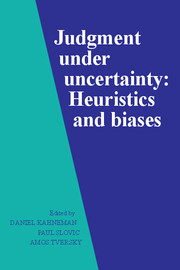Book contents
- Frontmatter
- Contents
- List of contributors
- Preface
- Part I Introduction
- Part II Representativeness
- Part III Causality and attribution
- Part IV Availability
- Part V Covariation and control
- 15 Informal covariation assessment: Data-based versus theory-based judgments
- 16 The illusion of control
- 17 Test results are what you think they are
- 18 Probabilistic reasoning in clinical medicine: Problems and opportunities
- 19 Learning from experience and suboptimal rules in decision making
- Part VI Overconfidence
- Part VII Multistage evaluation
- Part VIII Corrective procedures
- Part IX Risk perception
- Part X Postscript
- References
- Index
17 - Test results are what you think they are
Published online by Cambridge University Press: 05 May 2013
- Frontmatter
- Contents
- List of contributors
- Preface
- Part I Introduction
- Part II Representativeness
- Part III Causality and attribution
- Part IV Availability
- Part V Covariation and control
- 15 Informal covariation assessment: Data-based versus theory-based judgments
- 16 The illusion of control
- 17 Test results are what you think they are
- 18 Probabilistic reasoning in clinical medicine: Problems and opportunities
- 19 Learning from experience and suboptimal rules in decision making
- Part VI Overconfidence
- Part VII Multistage evaluation
- Part VIII Corrective procedures
- Part IX Risk perception
- Part X Postscript
- References
- Index
Summary
Every day psychiatrists and clinical psychologists must make vital decisions:
What is his problem? Should he be committed to a mental hospital? Is he a suicide-risk or a homicide-risk? Is this patient well enough to be discharged from the hospital or should he stay?
For help with their decisions the clinicians almost always use psychological tests.
According to a survey by Norman Sundberg, the two most widely used tests of any kind are the Rorschach inkblot test and the Draw-a-Person test (DAP). Both are projective tests, based on the premise that a person projects part of his personality when he responds to an ambiguous, unstructured situation. For example, since there are no objective shapes in an inkblot, anything a person sees in one presumably reflects his own drives, conflicts and personality. Similarly, when one draws a picture of a person on a blank sheet of paper, he is thought to project a bit of himself into his creation.
Self
Our recent research suggests that the Rorschach and DAP may be projective tests in more ways than one. In interpreting the results of these tests, the average clinician may project his own preconceptions and assumptions into his description of the patient.
Our first studies in this area were with the Draw-a-Person test, in which a clinician gives the subject a pencil and a blank sheet of paper and asks him to draw a person. Karen Machover published the test in 1949.
Information
- Type
- Chapter
- Information
- Judgment under UncertaintyHeuristics and Biases, pp. 239 - 248Publisher: Cambridge University PressPrint publication year: 1982
Accessibility standard: Unknown
Why this information is here
This section outlines the accessibility features of this content - including support for screen readers, full keyboard navigation and high-contrast display options. This may not be relevant for you.Accessibility Information
- 19
- Cited by
